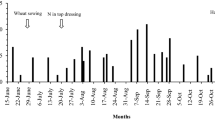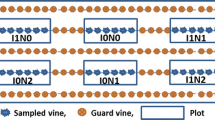Abstract
Precise management of nitrogen (N) using canopy color in aerial imagery of corn (Zea mays L.) has been proposed as a strategy on which to base the rate of N fertilizer. The objective of this study was to evaluate the relationship between canopy color and yield response to N at the field scale. Six N response trials were conducted in 2000 and 2001 in fields with alluvial, claypan and deep loess soil types. Aerial images were taken with a 35-mm slide film from ≥1100 m at the mid- and late-vegetative corn growth stages and processed to extract green and red digital values. Color values of the control N (0 kg N ha−1) and sufficient N (280 kg N ha−1 applied at planting) treatments were used to calculate the relative ratio of unfertilized to fertilized and relative difference color values. Other N fertilizer treatments included side-dressed applications in increments of 56 kg N ha−1. The economic optimal N rate was weakly related (R 2 ≤ 0.34) or not related to the color indices at both growth stages. For many sites, delta yield (the increase in yield between control N and sufficient N treatments) was related to the color indices (R 2 ≤ 0.67) at the late vegetative growth stage; the best relationship was with green relative difference. The results indicate the potential for color indices from aerial photographs to be used for predicting delta yield from which a site-specific N rate could be determined.





Similar content being viewed by others
References
Arregui, L. M., & Quemada, M. (2008). Strategies to improve nitrogen use efficiency in winter cereal crops under rainfed conditions. Agronomy Journal, 100, 277–284.
Arslan, S., & Colvin, T. S. (2002). An evaluation of the response of yield monitors and combines to varying yields. Precision Agriculture, 3, 107–122.
Bausch, W. C., & Duke, H. R. (1996). Remote sensing of plant nitrogen status in corn. Transactions of ASAE, 39, 1869–1875.
Birrell, S. J., Sudduth, K. A., & Borgelt, S. C. (1996). Comparison of sensors and techniques for crop yield mapping. Computers and Electronics in Agriculture, 14, 215–233.
Blackmer, T. M., & Schepers, J. S. (1996). Aerial photography to detect nitrogen stress in corn. Journal of Plant Physiology, 148, 440–444.
Blackmer, T. M., Schepers, J. S., & Varvel, G. E. (1994). Light reflectance compared with other nitrogen stress measurements in corn leaves. Agronomy Journal, 86, 934–938.
Blackmer, T. M., Schepers, J. S., Varvel, G. E., & Meyer, G. E. (1996). Analysis of aerial photography for nitrogen stress within corn fields. Agronomy Journal, 88, 729–733.
Bundy, L. G., & Andraski, T. W. (1995). Soil yield potential effects on performance of soil nitrate tests. Journal of Production Agriculture, 8, 561–568.
Flowers, M., Weisz, R., Heiniger, R., Tarleton, B., & Meijer, A. (2003). Field validation of a remote sensing technique for early nitrogen application decisions in wheat. Agronomy Journal, 95, 167–176.
Franzen, D. W., Cihacek, L. J., & Hofman, V. L. (1996). Variability of soil nitrate and phosphate under different landscapes. In P. C. Roberts, R. H. Rust, & W. E. Larson (Eds.), Proceedings of third international conference on precision agriculture (pp. 521–529). Madison, WI: American Society of Agronomy.
Hong, N., Scharf, P. C., Davis, J. G., Kitchen, N. R., & Sudduth, K. A. (2007). Economically optimal nitrogen rate reduces soil residual nitrate. Journal of Environmental Quality, 36, 354–362.
Kitchen, N. R., & Goulding, K. W. T. (2001). On-farm technologies and practices to improve nitrogen use efficiency. In R. F. Follet & J. L. Hatfield (Eds.), Nitrogen in the environment: Sources, problems, and management (pp. 335–369). Amsterdam, The Netherlands: Elsevier Science B.V.
Long, D. S., Neilsen, G. A., & Carlson, G. R. (1989). Use of aerial photography for improving layout of field research plots. Applied Agricultural Research, 4, 96–100.
Lory, J. A., & Scharf, P. C. (2003). Yield goal versus delta yield for predicting fertilizer nitrogen need in corn. Agronomy Journal, 95, 994–999.
Mullen, R. W., Freeman, K. W., Raun, W. R., Johnson, G. V., Stone, M. L., & Solie, J. B. (2003). Identifying an in-season response index and the potential to increase wheat yield with nitrogen. Agronomy Journal, 95, 347–351.
Pinter, P. J., Hatfield, J. L., Schepers, J. S., Barnes, E. M., Moran, M. S., Daughtry, C. S. T., et al. (2003). Remote sensing for crop management. American Society for Photogrammetry and Remote Sensing, 69, 647–664.
Puckett, L. J., Zamora, C., Essaid, H., Wilson, J. T., Johnson, H. M., Brayton, M. J., et al. (2008). Transport and fate of nitrate at the ground-water/surface-water interface. Journal of Environmental Quality, 37, 1034–1050.
Rice, C. W., & Havlin, J. L. (1994). Integrating mineralizable nitrogen indices into fertilizer nitrogen recommendations. In J. L. Havlin & J. S. Jacobsen (Eds.), Soil testing: Prospects for improving nutrient recommendations (pp. 1–13). Madison, WI: Soil Science Society of America.
Ritchie, S. W., Hanway, J. J., & Benson, G. O. (1993). How a corn plant develops. Special Report, 48. Ames: Iowa State University.
Sawyer, J., Nafziger, E., Randall, G., Bundy, L., Rehm, G., & Joern, B. (2006). Concepts and rationale for regional nitrogen rate guidelines for corn. Iowa State University Extension Publication, PM 2015.
Scharf, P. C., Brouder, S. M., & Hoeft, R. G. (2006a). Chlorophyll meter readings can predict nitrogen need and yield response of corn in the north-central USA. Agronomy Journal, 98, 655–665.
Scharf, P. C., Kitchen, N. R., Sudduth, K. A., & Davis, J. G. (2006b). Spatially variable corn yield is a weak predictor of optimal nitrogen rate. Soil Science Society of America Journal, 70, 2154–2160.
Scharf, P. C., Kitchen, N. R., Sudduth, K. A., Davis, J. G., Hubbard, V. C., & Lory, J. A. (2005). Field-scale variability in economically-optimal N fertilizer rate for corn. Agronomy Journal, 97, 452–461.
Scharf, P. C., & Lory, J. A. (2002). Calibrating corn color from aerial photographs to predict sidedress N need. Agronomy Journal, 94, 397–404.
Schepers, J. S., Blackmer, T. M., Wilhelm, W. W., & Resende, M. (1996). Transmittance and reflectance measurements of corn leaves from plants with different nitrogen and water supply. Journal of Plant Physiology, 148, 523–529.
Schepers, J. S., Frank, K. D., & Bourg, C. (1986). Effect of yield goal and residual soil nitrogen concentration on N fertilizer recommendations for irrigated maize in Nebraska. Journal of Fertilizer Issues, 3, 133–139.
Schepers, J. S., & Mosier, A. R. (1991). Accounting for nitrogen in nonequilibrium soil-crop systems. In R. F. Follett, D. R. Keeney, & R. M. Cruse (Eds.), Managing nitrogen for groundwater quality and farm profitability (pp. 125–128). Madison, WI: Soil Science Society of America.
Shanahan, J. F., Schepers, J. S., Francis, D. D., Varvel, G. E., Wilhelm, W. W., Tringe, J. M., et al. (2001). Use of remote sensing imagery to estimate corn grain yield. Agronomy Journal, 93, 583–589.
Sripada, R. P., Heiniger, R. W., White, J. G., & Meijer, A. D. (2006). Aerial color infrared photography for determining early in-season nitrogen requirements in corn. Agronomy Journal, 98, 968–977.
Stone, M. L., Solie, J. B., Raun, W. R., Whitney, R. W., Taylor, S. L., & Ringer, J. D. (1996). Use of spectral radiance for correcting in-season fertilizer nitrogen deficiencies in winter wheat. Transactions of the ASAE, American Society of Agricultural Engineers, 39, 1623–1631.
Sudduth, K. A., Birrel, S. J., & Krumpelman, M. J. (2000). Field evaluation of corn population sensor. In P. C. Roberts, R. H. Rust, & W. E. Larson (Eds.), Proceedings of the fifth international conference on precision agriculture (paper 252). Madison, WI: American Society of Agronomy. CD format only.
Sudduth, K. A., & Drummond, S. T. (2007). Yield editor: Software for removing errors from crop yield maps. Agronomy Journal, 99, 1471–1482.
Teal, R. K., Tubana, B., Girma, K., Freeman, K. W., Arnall, D. B., Walsh, O., et al. (2006). In-season prediction of corn grain yield potential using normalized difference vegetation index. Agronomy Journal, 98, 1488–1494.
USEPA. (Aug 2002). National water quality inventory: 2000 report. EPA-841-R-02-001, Washington, DC.
USDA ERS. (2005). Farm business and household survey data: Summaries from ARMS. 2005 Survey. http://www.ers.usda.gov/data/ARMS/app/Crop.aspx.
Williams, J. D., Crozier, C. R., Crouse, D. A., White, J. G., Bang, J., & Duffera, M. (2005). Spatial relationships between soil amino sugar nitrogen, soil properties, and landscape attributes. In J. V. Stafford (Ed.), Proceedings of the fifth European conference on precision agriculture (pp. 303–309). Wageningen: Wageningen Academic Scientific Publishers.
Wolfe, D. W., Henderson, D. W., Hsaio, T. C., & Alvino, A. (1988). Interactive water and nitrogen effects on senescence of maize: II. Photosynthetic decline and longevity of individual leaves. Agronomy Journal, 80, 865–870.
Author information
Authors and Affiliations
Corresponding author
Additional information
Disclaimer: Mention of trade names or commercial products in this article is solely for the purpose of providing specific information and does not imply recommendation or endorsement by the US Department of Agriculture or the University of Missouri.
Rights and permissions
About this article
Cite this article
Williams, J.D., Kitchen, N.R., Scharf, P.C. et al. Within-field nitrogen response in corn related to aerial photograph color. Precision Agric 11, 291–305 (2010). https://doi.org/10.1007/s11119-009-9137-x
Received:
Accepted:
Published:
Issue Date:
DOI: https://doi.org/10.1007/s11119-009-9137-x




